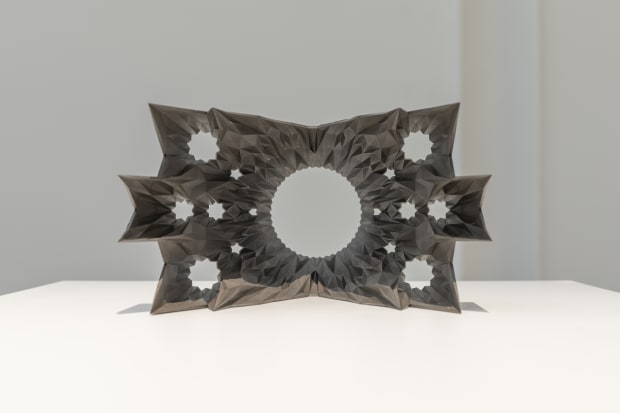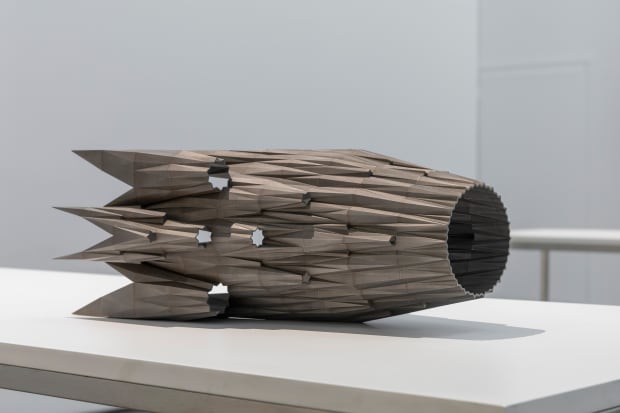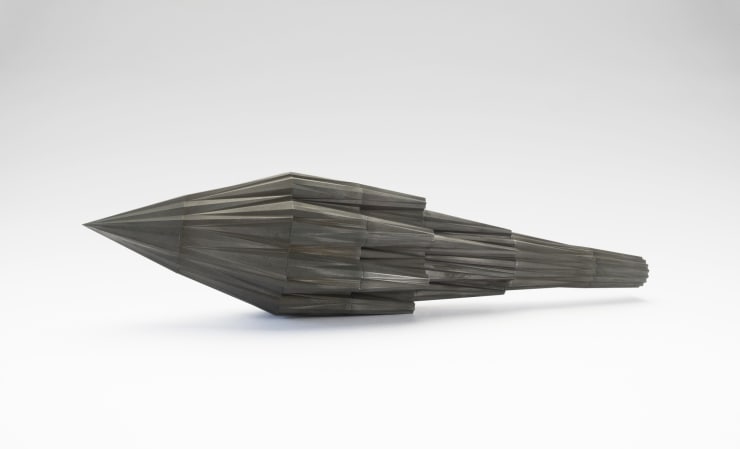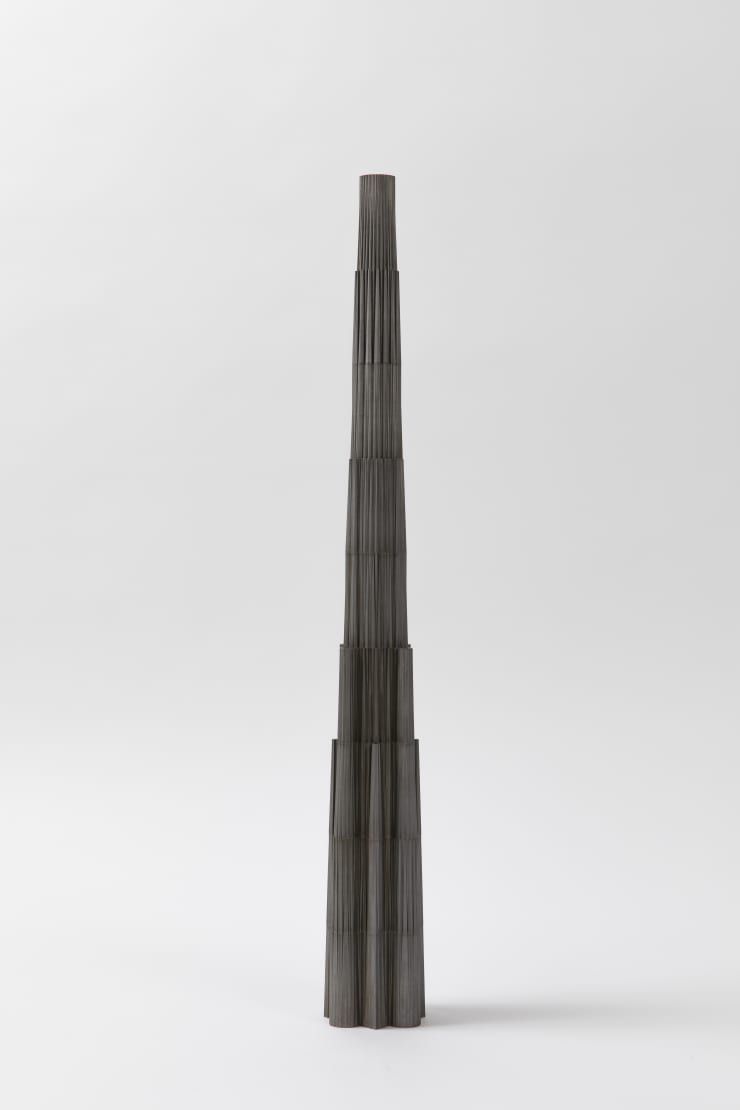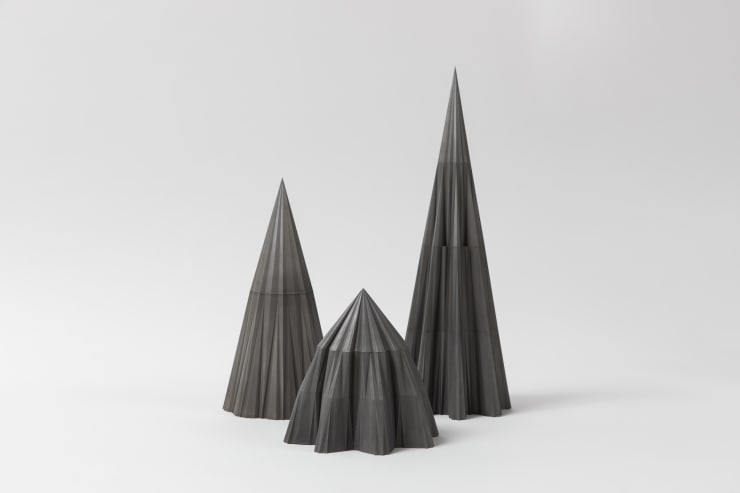-
SAHAND HESAMIYAN
PROPLESIS
-
The Third Line is pleased to announce our third solo exhibition with Sahand Hesamiyan. Marking the artist’s 24-year journey with steel, Prolepsis will showcase a collection of sculptures that celebrate his dedication to this medium, and shine a light on a trove of long-cherished yet unrealised projects.
-
Latent Potency: The Speculative Power of Sahand Hesamiyan’s Sculptures
Kevin Jones -
 Installation view, Sahand Hesamiyan, Prolepsis, 2023, The Third Line. Photo credit Ismail Noor, Seeing Things Studio
Installation view, Sahand Hesamiyan, Prolepsis, 2023, The Third Line. Photo credit Ismail Noor, Seeing Things Studio -
-
 Sahand Hesamiyan, Pillars of Victory, 2023, Steel Mo40 Steel 45 Rockwell Hardness, Two Pieces, 45 x 11 x 11 cm, 37 x 9.7 x 9.7 cm, Edition of 3, 2AP
Sahand Hesamiyan, Pillars of Victory, 2023, Steel Mo40 Steel 45 Rockwell Hardness, Two Pieces, 45 x 11 x 11 cm, 37 x 9.7 x 9.7 cm, Edition of 3, 2AP -
"While it is true that the works in Prolepsis contain the DNA of unrealized projects, they hold a power far more potent than mere intention, than some embryonic signpost of an imagined outcome."
While it is true that the works in Prolepsis contain the DNA of unrealized projects, they hold a power far more potent than mere intention, than some embryonic signpost of an imagined outcome. They are eminently self-referential[1], harking back to the very process from which they sprang. Hesamiyan shows us the murky area of creation—the zoomed-in joinery, the projected material and finishing, the intricacy of receding muqarnas. ‘Maquette’ seems insufficient as a descriptor, relying as it does on conjecture, on a ‘might happen.’ Equally, ‘prototype’ is bogged down in testing and hypotheses. Hesamiyan’s works are narratives in their own right, less beholden to the ‘final’ work, more jockeying between inception and conclusion. The rhetorical device of prolepsis, from which the show slyly takes its title, foregrounds this movement. Commonly known as a ‘flash-forward’ (the temporal counterpart of flashback), prolepsis is an anticipation: it represents an inexistent thing as existing, from within the moment of speaking. Time is collapsed, and the narration fills the void. Hesaminyan’s works in Prolepsis repeatedly leap between this moment of speech (the work made manifest), back to a shadowy genesis, and forward to an inexistent existence. This is a complex dance; one he has never shown us before.
-
-
 Sahand Hesamiyan, Kayhan, 2023, Steel Mo40 Steel 45 Rockwell Hardness, 28.4 x 40.7 x 16 cm, Edition of 3, 2AP
Sahand Hesamiyan, Kayhan, 2023, Steel Mo40 Steel 45 Rockwell Hardness, 28.4 x 40.7 x 16 cm, Edition of 3, 2AP -
[1] I remember a 2016 visit to Hesamiyan’s Tehran studio and a small sculpture lying atop a worktable I had discovered accidentally. Nail (2012) was a slice of metal folded to resemble a nail—a sharp, spike of a statement. It struck me how this work was talking about itself, its own imbrication in a process of creating sculpture that is, ultimately, itself.
-
Worklist
-
 Sahand HesamiyanEmtedad, 2023Steel Mo40 Steel 45 Rockwell Hardness7.6 x 56.8 x 7.6 cmEdition 1 of 3, 2AP
Sahand HesamiyanEmtedad, 2023Steel Mo40 Steel 45 Rockwell Hardness7.6 x 56.8 x 7.6 cmEdition 1 of 3, 2AP -
 Sahand HesamiyanKanoon I, 2020Steel Mo40 Steel 45 Rockwell Hardness40 x 9.5 x 10 cmAP1, Edition of 3, 2AP
Sahand HesamiyanKanoon I, 2020Steel Mo40 Steel 45 Rockwell Hardness40 x 9.5 x 10 cmAP1, Edition of 3, 2AP -
 Sahand HesamiyanKhesht I, 2023Steel Mo40 Steel 45 Rockwell Hardness9 x 9 x 5 cmEdition 1 of 10, 3AP
Sahand HesamiyanKhesht I, 2023Steel Mo40 Steel 45 Rockwell Hardness9 x 9 x 5 cmEdition 1 of 10, 3AP -
 Sahand HesamiyanKhesht II, 2023Copper9 x 9 x 5 cmEdition 1 of 10, 3AP
Sahand HesamiyanKhesht II, 2023Copper9 x 9 x 5 cmEdition 1 of 10, 3AP -
 Sahand HesamiyanKhesht III, 2023Steel Mo40 Steel 45 Rockwell Hardness9 x 9 x 5 cmEdition 1 of 10, 3AP
Sahand HesamiyanKhesht III, 2023Steel Mo40 Steel 45 Rockwell Hardness9 x 9 x 5 cmEdition 1 of 10, 3AP -
 Sahand HesamiyanMejmar I, 2023Steel Mo40 Steel 45 Rockwell Hardness11.5 x 26.4 x 11.5 cmEdition 1 of 3, 2AP
Sahand HesamiyanMejmar I, 2023Steel Mo40 Steel 45 Rockwell Hardness11.5 x 26.4 x 11.5 cmEdition 1 of 3, 2AP -
 Sahand HesamiyanMejmar II, 2023Steel Mo40 Steel 45 Rockwell Hardness11.5 x 21.2 x 11.5 cmEdition 1 of 3, 2AP
Sahand HesamiyanMejmar II, 2023Steel Mo40 Steel 45 Rockwell Hardness11.5 x 21.2 x 11.5 cmEdition 1 of 3, 2AP -
 Sahand HesamiyanMenar, 2020Steel Mo40 Steel 45 Rockwell Hardness64.7 x 7.8 x 7.8 cmEdition of 3, 2AP
Sahand HesamiyanMenar, 2020Steel Mo40 Steel 45 Rockwell Hardness64.7 x 7.8 x 7.8 cmEdition of 3, 2AP -
 Sahand HesamiyanNeshaan, 2023Steel Mo40 Steel 45 Rockwell Hardness12.5 x 12.5 x 35.5 cm. 12 x 12 x 23.9 cm.14.7 x 14.7 x 13.7 cmEdition of 3, 2AP
Sahand HesamiyanNeshaan, 2023Steel Mo40 Steel 45 Rockwell Hardness12.5 x 12.5 x 35.5 cm. 12 x 12 x 23.9 cm.14.7 x 14.7 x 13.7 cmEdition of 3, 2AP -
 Sahand HesamiyanUntitled, 2020Steel Mo40 Steel 45 Rockwell Hardness7 x 29 x 7 cmEdition 1 of 3, 2AP
Sahand HesamiyanUntitled, 2020Steel Mo40 Steel 45 Rockwell Hardness7 x 29 x 7 cmEdition 1 of 3, 2AP -
 Sahand HesamiyanKanoon II, 2020Steel Mo40 Steel 45 Rockwell Hardness24.5 x 9.5 x 10 cmAP1, Edition of 3, 2AP
Sahand HesamiyanKanoon II, 2020Steel Mo40 Steel 45 Rockwell Hardness24.5 x 9.5 x 10 cmAP1, Edition of 3, 2AP
-
Sahand Hesamiyan: Prolepsis
Past viewing_room

